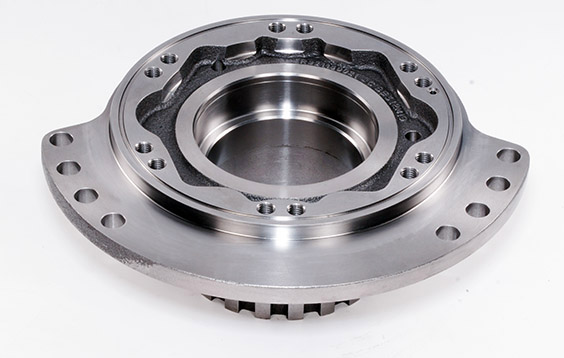OEM (Original Equipment Manufacturer) steel casting refers to the process of producing investment steel castings based on the specifications and requirements of a particular manufacturer or brand. Steel casting involves pouring molten steel into a mold to create a desired shape. OEM steel casting is commonly used in various industries, including automotive, machinery, construction, and more.
The OEM steel casting process typically involves the following steps:
- Design and Engineering: The manufacturer works with engineers and designers to create the specifications and design for the desired steel casting.
- Pattern Making: A pattern or mold is created based on the design. This pattern is typically made from wood, plastic, or metal and serves as a template for the final casting.
- Mold Preparation: The pattern is used to create a mold, which is typically made from sand or refractory material. The mold is prepared by packing the material around the pattern and allowing it to harden.
- Melting and Pouring: The steel is melted in a furnace at high temperatures. Once the steel reaches the desired temperature and consistency, it is poured into the prepared mold.
- Cooling and Solidification: The molten steel cools and solidifies within the mold, taking on the shape of the pattern. Cooling times can vary depending on the size and complexity of the casting.
- Shakeout and Cleaning: After the steel has solidified, the mold is broken away, and the casting is removed. The casting may undergo various cleaning processes, such as shot blasting or sandblasting, to remove any residual mold material or surface impurities.
- Finishing and Machining: The casting may require additional finishing processes, such as grinding, polishing, or machining, to achieve the desired dimensions, surface quality, and functional requirements.
- Inspection and Quality Control: The casting undergoes rigorous inspection to ensure it meets the specified requirements and quality standards. This may include dimensional checks, visual inspection, non-destructive testing (such as X-ray or ultrasound), and mechanical testing.
- Surface Treatment and Coating (Optional): Depending on the application and requirements, the casting may undergo surface treatments or coatings, such as painting, plating, or heat treatment, to enhance its properties or protect against corrosion.
OEM steel casting allows manufacturers to produce custom-made steel components that meet their specific needs and can be seamlessly integrated into their products or equipment. It offers versatility, durability, and the ability to create complex shapes and designs, making it a popular choice in many industries.

Advantages of OEM Steel Casting
Steel castings offer several advantages over other manufacturing processes and materials. Here are some key advantages of steel castings:
- Design Flexibility: Steel castings provide high design flexibility, allowing for the creation of complex shapes and intricate details that may be difficult or costly to achieve through other manufacturing methods. This makes steel castings suitable for a wide range of applications with diverse geometries and specifications.
- Strength and Durability: Steel is known for its exceptional strength and durability. Steel castings can withstand heavy loads, high temperatures, and harsh environments, making them suitable for demanding applications in industries such as automotive, aerospace, construction, and energy.
- Weight Reduction: Steel castings can be designed to have thinner walls and reduced weight compared to other materials without compromising strength or structural integrity. This weight reduction can lead to improved fuel efficiency, easier handling, and reduced transportation costs.
- Cost-Effective Production: Steel castings offer cost advantages in large-scale production runs. Once the casting mold is prepared, multiple castings can be produced quickly and efficiently, reducing labor costs and overall production time. Additionally, steel’s durability and longevity can result in lower maintenance and replacement costs over the product’s lifecycle.
- Material Versatility: Steel is available in a wide range of grades and alloys, each with its specific properties and characteristics. This allows manufacturers to select the most suitable steel alloy for their application, ensuring optimal performance in terms of strength, corrosion resistance, heat resistance, wear resistance, and more.
- Consistency and Reproducibility: Steel castings can achieve a high level of dimensional accuracy and consistency, ensuring uniformity and reproducibility across multiple production batches. This is particularly important for critical components that require precise tolerances and reliable performance.
- Enhanced Mechanical Properties: Steel castings can be heat treated and post-processed to improve their mechanical properties, such as hardness, toughness, and wear resistance. These treatments can further enhance the performance and longevity of the castings, allowing them to withstand demanding operating conditions.
- Corrosion Resistance: Certain steel alloys exhibit excellent corrosion resistance, making steel castings suitable for applications exposed to corrosive environments or chemicals. Additionally, protective coatings and surface treatments can be applied to steel castings to enhance their resistance to corrosion.
- Environmental Sustainability: Steel is a highly recyclable material, and steel castings can be recycled and reused, reducing waste and conserving resources. The recyclability of steel castings contributes to a more sustainable manufacturing process and aligns with environmental initiatives.
Overall, OEM steel castings offer a combination of strength, design flexibility, durability, and cost-effectiveness, making them a preferred choice for many industries where reliable and high-performance components are required.

Types of OEM Steel Casting
Cast Steel has many types. According to chemical composition, cast steels are categorized into two general groups. These are carbon cast steels and alloy cast steels.
Carbon Steels
Carbon steels are special types of steel. Because it has a higher concentration of carbon. It also has types of low carbon steel,medium-carbon steel,high-carbon steel. With this, it provides a lot more benefits to its users. Carbon steels are stronger and more durable as compared to ordinary steels. It is more resistant to stress but may still break if exposed excessively. This type of cast steel is being used in industries like construction, automotive, and many others.
Generally speaking,low carbon steel ZG15 has a higher melting point, but poor casting performance. It is only used to manufacture motor parts or carburized parts.
Medium carbon steel ZG25~ZG45 has comprehensive properties higher than all kinds of cast iron. That is a high strength, excellent plasticity, and toughness. Therefore, it is suitable for manufacturing parts with complex shapes, high strength, and toughness requirements. Such as train wheels, forging hammer stands and anvils, rolls, and high-pressure valves. It is the most widely used type of carbon cast steel.
The high carbon steel ZG55 has a low melting point. Its casting performance is better than that of medium carbon steel. But its plasticity and toughness are poor. It is only used to manufacture a few wear parts.
Alloy Steels
Alloy steels are formed when elements that are composed of metals and non-metals are joined with carbon steels. These are used in many industries such as mining, automobiles, road construction, and many more. Alloy steels are not just for big components, they are also used to make small and basic household equipment.
According to the total amount of alloying elements, alloy cast steel can be divided into two categories: low alloy steel and high alloy steel.
(1) Low alloy cast steel. my country mainly uses manganese series, manganese silicon series and chromium series. Such as ZG40Mn, ZG30MnSi1, ZG30Cr1MnSi1, etc. Used to make parts such as gears, hydraulic press working cylinders and hydraulic turbine rotors. And ZG40Cr1 is commonly used to manufacture important stressed parts such as high-strength gears and high-strength shafts.
(2) High alloy cast steel. It has special properties such as wear resistance, heat resistance or corrosion resistance. Such as high manganese steel ZGMn13. It is a kind of anti-wear steel. Mainly used to manufacture parts used under dry friction working conditions. Such as the front wall and teeth of the grab bucket of excavators, the crawler tracks of tractors and tanks, etc. Chromium-nickel stainless steel ZG1Cr18Ni9 and chromium stainless steel ZG1Cr13 and ZGCr28, etc. High corrosion resistance to nitric acid. Mainly used in the manufacture of chemical, petroleum, chemical fiber, food and other equipment parts.
In comparison, while both types of steel are useful and in demand, they are the total contrast in terms of their properties. Alloy steels are more corrosion resistant than carbon steels. But its strength and durability are inferior to carbon steel. There are many contrasting properties and elements between carbon steels and alloy steels. But in the end, both are highly useful for many industries and trades.
Applications of OEM Steel Casting
Steel castings are efficient in many applications. Therefore, it has become in-demand in the market. Its popularity is still growing worldwide.
- Railway Locomotives
Many of the key elements in railway locomotives use steel castings. You may find them in components like side frames, wheels, couplers, and bolsters.
- Power Station Apparatus
Different components in thermal and nuclear power stations use steel casting to ensure durability and efficiency. The properties that cast steels possess make them a reliable component in this industry.
- Construction Equipment
Building and construction industry need tools and equipment that can withstand high stress and pressure. So, cast steels are perfect for making construction equipment and components such as wheels, load wheels, and many others.
- Mining Equipment
Mining is a fragile industry. Everything used in its operations needs to be durable and can offer safety to its workers. Steel casting is carefully used in creating the needed equipment for this industry.
- Aerospace Equipment
Steel castings have been used in different aerospace equipment even from way back. Some of the key components used in aerospace are made of cast steel such as engine brackets, brake support plates, and many others.
- Agricultural Machines
Many agricultural machines go through harsh conditions, and this makes steel castings very efficient.
Where to find a reliable steel casting foundry in China?
There are numerous OEM steel casting foundries in China. Here are a few well-known ones:
- Dongying Hengke precision metal Co., Ltd Website: www.hengkemetal.com
WhatsApp: 86-13371534537
Types of OEM steel casting Products:
– Valve Parts
– Electronic Tools
– Marine Equipment Components
– Automobile Parts
– Construction Hardware
– Pump Parts

2. Xinghua Dongchang Alloy Steel Co., Ltd. (Xinghua, Jiangsu Province) Website: http://www.dcalloy.com/
3. Dongying Giayoung Precision Metal Co., Ltd. (Dongying, Shandong Province) Website: http://www.dongyinglostwax.com/
4. Ningbo Yinzhou Fuchun Precision Casting Co., Ltd. (Ningbo, Zhejiang Province) Website: http://www.investmentcastingchina.com/
5. CFS Foundry (Zhengzhou, Henan Province) Website: http://www.investmentcastchina.com/
It’s important to note that when selecting a steel casting foundry, it is recommended to thoroughly research and evaluate their capabilities, quality control measures, certifications, production capacity, and customer reviews to ensure they meet your specific requirements. Additionally, consider factors such as communication, lead times, and shipping options when working with a foundry in China.
